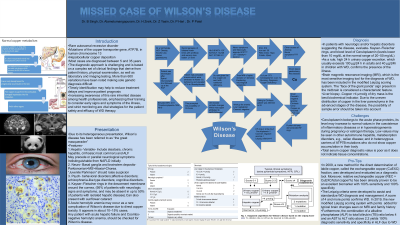Tuesday Poster Session
Category: Liver
P3989 - Missed Case of Wilson’s
Tuesday, October 24, 2023
10:30 AM - 4:00 PM PT
Location: Exhibit Hall

Has Audio
- BS
Bipneet Singh, MBBS
Henry Ford Jackson
Jackson, MI
Presenting Author(s)
Bipneet Singh, MBBS1, Hassan Zreik, MD2, Parneet Hari, MD1, Zarqa Yasin, MD3, Parth M. Patel, MD4, Chidamber Bharath Alamelumangapuram, MD1
1Henry Ford Jackson, Jackson, MI; 2Henry Ford Health System, Jackson, MI; 3Henry Ford Health, Jackson, MI; 4Henry Ford Health System, Boston, MA
Introduction: Wilson disease is an autosomal recessive disorder of copper metabolism due to impaired function of the intracellular copper transporter ATP7B. It has a prevalence of approximately one case in 30,000 live births in most populations. Patients may present with a wide variety of even within the same family. There is wide variability in the reported rates of the different clinical manifestations seen at the time of presentation. Regardless of whether clinical manifestations are initially present, patients often develop other clinical manifestations as the disease progresses
Case Description/Methods: 34-year-old woman with past medical history of obesity, alcohol use, multi-nutritional deficiency secondary to sleeve gastrectomy presented with progressively worsening lower limb weakness. She was hemodynamically stable and had flaccid paralysis of bilateral lower limbs with areflexia and sensory loss of L1 level. Initial lab work was significant for hemolytic anemia, elevated liver enzymes and micronutrient deficiencies including low copper, zinc and folate. An MRI of the spine which revealed severe stenosis of the at T 12-L1 level. She underwent neurosurgery with neurological improvement; however, she had persistent elevation in liver enzymes with elevated INR, borderline thrombocytopenia, hypoalbuminemia. It was deemed to be likely secondary to NASH. Eventually GI was involved, a low level of copper prompted testing for serum ceruloplasmin level and urine 24-hour copper level. Ceruloplasmin resulted low but was non diagnostic by itself since it can be low in malnourished states. The patient was discharged, and urine copper showed increased copper excretion which in the setting of low ceruloplasmin, anemia and elevated liver enzymes was high risk for Wilson's disease by Leipzig criterion. Patient underwent outpatient liver biopsy which confirmed Wilson's disease
Discussion: The median survival following the development of neurologic symptoms was approximately five years. Patients who develop acute liver failure due to Wilson disease have an acute mortality rate of at least 95 percent in the absence of a liver transplantation. However, prognosis for patients who receive and are adherent to treatment for Wilson disease is excellent, even in some who already have advanced liver disease. So in patients with high suspicion of Wilson’s disease, a complete diagnostic workup should be done given the excellent prognosis while on therapy and high morbidity associated when complications set in.
Disclosures:
Bipneet Singh, MBBS1, Hassan Zreik, MD2, Parneet Hari, MD1, Zarqa Yasin, MD3, Parth M. Patel, MD4, Chidamber Bharath Alamelumangapuram, MD1. P3989 - Missed Case of Wilson’s, ACG 2023 Annual Scientific Meeting Abstracts. Vancouver, BC, Canada: American College of Gastroenterology.
1Henry Ford Jackson, Jackson, MI; 2Henry Ford Health System, Jackson, MI; 3Henry Ford Health, Jackson, MI; 4Henry Ford Health System, Boston, MA
Introduction: Wilson disease is an autosomal recessive disorder of copper metabolism due to impaired function of the intracellular copper transporter ATP7B. It has a prevalence of approximately one case in 30,000 live births in most populations. Patients may present with a wide variety of even within the same family. There is wide variability in the reported rates of the different clinical manifestations seen at the time of presentation. Regardless of whether clinical manifestations are initially present, patients often develop other clinical manifestations as the disease progresses
Case Description/Methods: 34-year-old woman with past medical history of obesity, alcohol use, multi-nutritional deficiency secondary to sleeve gastrectomy presented with progressively worsening lower limb weakness. She was hemodynamically stable and had flaccid paralysis of bilateral lower limbs with areflexia and sensory loss of L1 level. Initial lab work was significant for hemolytic anemia, elevated liver enzymes and micronutrient deficiencies including low copper, zinc and folate. An MRI of the spine which revealed severe stenosis of the at T 12-L1 level. She underwent neurosurgery with neurological improvement; however, she had persistent elevation in liver enzymes with elevated INR, borderline thrombocytopenia, hypoalbuminemia. It was deemed to be likely secondary to NASH. Eventually GI was involved, a low level of copper prompted testing for serum ceruloplasmin level and urine 24-hour copper level. Ceruloplasmin resulted low but was non diagnostic by itself since it can be low in malnourished states. The patient was discharged, and urine copper showed increased copper excretion which in the setting of low ceruloplasmin, anemia and elevated liver enzymes was high risk for Wilson's disease by Leipzig criterion. Patient underwent outpatient liver biopsy which confirmed Wilson's disease
Discussion: The median survival following the development of neurologic symptoms was approximately five years. Patients who develop acute liver failure due to Wilson disease have an acute mortality rate of at least 95 percent in the absence of a liver transplantation. However, prognosis for patients who receive and are adherent to treatment for Wilson disease is excellent, even in some who already have advanced liver disease. So in patients with high suspicion of Wilson’s disease, a complete diagnostic workup should be done given the excellent prognosis while on therapy and high morbidity associated when complications set in.
Disclosures:
Bipneet Singh indicated no relevant financial relationships.
Hassan Zreik indicated no relevant financial relationships.
Parneet Hari indicated no relevant financial relationships.
Zarqa Yasin indicated no relevant financial relationships.
Parth Patel indicated no relevant financial relationships.
Chidamber Bharath Alamelumangapuram indicated no relevant financial relationships.
Bipneet Singh, MBBS1, Hassan Zreik, MD2, Parneet Hari, MD1, Zarqa Yasin, MD3, Parth M. Patel, MD4, Chidamber Bharath Alamelumangapuram, MD1. P3989 - Missed Case of Wilson’s, ACG 2023 Annual Scientific Meeting Abstracts. Vancouver, BC, Canada: American College of Gastroenterology.
